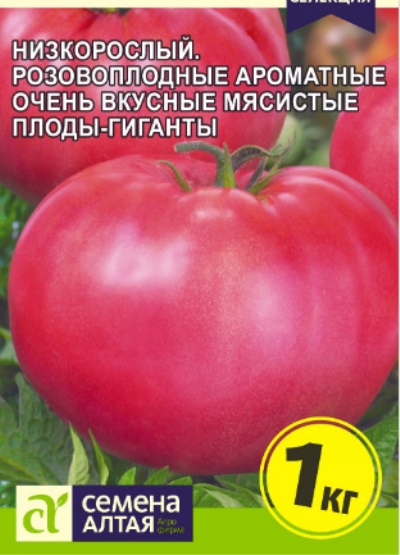
- Authors: Kudryavtseva G.A., Fotev Yu.V., Kotelnikova M.A., Kondakov S.N. (LLC "Center for breeding technologies")
- Year of approval: 2009
- Category: grade
- Growth type: determinant
- Appointment: fresh consumption, for pickling and preserving
- Ripening period: mid-early
- Ripening time, days: 105-109
- Growing conditions: for open ground, for film greenhouses
- Bush size: undersized
- Bush height, cm: 55-75
The total number of tomato varieties and hybrids offered by catalogs is in the thousands. One of the most popular and beloved by gardeners is the determinant variety Biysk rosan, which is distinguished by its good taste, high content of nutrients and attractive appearance. The unpretentious tomato is intended for growing in open ground and in greenhouses, its fruits are consumed fresh and used for canning.
Breeding history
The variety was bred by breeders G. A. Kudryavtseva, Yu. V. Foteva, M. A. Kotelnikova, S. N. Kondakova from the company OOO Center for Breeding Technologies. The variety began to be used in 2009.
Description of the variety
Low-growing (55–75 cm), well-leafy compact bushes have a strong spreading structure, covered with corrugated, slightly pubescent green leaves. The plant forms simple inflorescences, the fruits are attached to an articulated stalk. The tomato needs shaping, pinching, tying.
Advantages | disadvantages |
Large-fruited | Need support |
High yield | There is a need for shaping and pinning |
Resistant to cold spells | Fruits cannot be stored for a long time |
Tomato fruit tastes great | Large habitus limits the number of plants per sq. meter |
All these shortcomings can be called conditional, since most of them are characteristic features of the culture.
The main qualities of the fruit
Large fruits of a flat-round, highly ribbed shape are covered with a delicate skin, which makes it difficult to store the crop for a long time. Green unripe fruits acquire a deep pink color at the stage of technical ripeness. The mass of tomatoes is from 250 g to 1 kilogram.
Taste characteristics
The juicy pulp of the fruit has a crystalline structure, sugary at the break, has a sweet dessert taste and delicate aroma. The seed chambers contain a small amount of seeds.
Ripening and fruiting
A mid-early variety of tomatoes, its fruiting begins from 105-109 days from the time of sowing. Fruiting is extended, long-term. Harvesting: July - September.
Yield
Biysk rose is a high-yielding plant, 4.6 kilograms are harvested from a square meter of plantings.
The timing of planting seedlings and planting in the ground
Seeds for seedlings are sown in March, grown seedlings are planted in a greenhouse or open ground after 60-65 days.

Growing tomato seedlings is an extremely important process, because it largely depends on whether the gardener will be able to harvest at all. All aspects must be taken into account, from seedbed preparation to planting in the ground.
Landing scheme
When preparing the soil for planting seedlings, observe the 40x40 cm scheme.

Growing and care
Seeds prepared for sowing should be treated and disinfected with special stimulants (Epin-Extra, Zircon, HB101, Fitosporin and others). After sowing, it is necessary to organize a "greenhouse", grow after germination with sufficient lighting so that the plants do not stretch out. Barely sprouted shoots are watered moderately, rather moisten. The grown seedlings dive at the stage of 2-3 true leaves. When landing in open ground, sunny places are selected. The soil should be fertile, breathable, with a neutral pH level, warmed up to a temperature of + 15 ... 17 degrees and more.
After planting at the optimum distance, young plants shed well, and the next day they loosen the soil. Grooming procedures consist in timely watering, weeding, dressing. The variety needs mandatory formation of 1-2 stems in the garden, 2-4 in the greenhouse, as well as subsequent pinching. Tomatoes need nitrogen fertilizers to build up vegetative mass, phosphorus-potassium preparations, organic matter. Regular watering is carried out before the onset of the ripening period, after which watering is stopped.




A plant needs different micronutrients at each stage of growth. All fertilizers can be divided into two groups: mineral and organic. Folk remedies are often used: iodine, yeast, bird droppings, eggshells.
It is important to observe the rate and period of feeding. This also applies to folk remedies and organic fertilizers.
Disease and pest resistance
The variety is considered resistant to pathogens, but does not have a good resistance to fungal diseases typical of the Solanaceae group. In addition, the tomato can be attacked by pests, so preventive treatments with insecticides and fungicides are needed.


Resistant to adverse weather conditions
Biysk rose tree tolerates short-term extreme cold snap well.
Growing regions
The variety grows well and bears fruit throughout Russia, except for the Arctic. These are the Northern, North-Western, Central, Volgo-Vyatka, TsChO, North Caucasian, Middle Volga, Lower Volga, Ural, West Siberian, East Siberian, Far Eastern regions.
Reviews
Most gardeners and farmers appreciate the Biysk rose tree for its fleshy structure and large fruit. Excellent indicators of fruiting stability allow gardeners to plan for future crops, for which many prefer the variety. In addition, everyone notes the excellent taste, delicate skin, almost not felt during meals, and the high sugar content of the fruit.

























































































